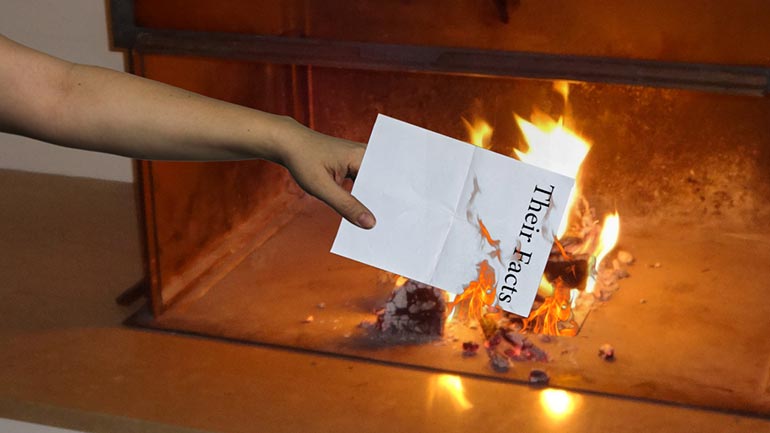ShmoopTube
Where Monty Python meets your 10th grade teacher.
Search Thousands of Shmoop Videos
ELA 5: How to Build a Case in Literary Analysis 265 Views
Share It!
Description:
If you're building a case involving literature does that make it a...bookcase? Well, not in this case. Check out the video to learn all about what makes great literary analyses. Bookcases are only tangentially involved.
Transcript
- 00:03
[Coop and Dino singing]
- 00:13
Donna has been assigned to write a paper about her favorite topic of all time…
- 00:18
…ponies. [Donna in her room with a pink pony poster on the wall]
- 00:19
Well…technically, it’s supposed to be about endangered animals, but…she hasn’t
- 00:23
seen too many ponies trotting past her window lately, so…that’s good enough for her! [Donna looking out a window and a pony trots past]
Full Transcript
- 00:28
Donna knows she needs to start her paper with a topic sentence.
- 00:32
The topic sentence identifies the topic and…just sorta gives your reader a rough idea
- 00:36
about what you’re going to say.
- 00:39
The supporting statements provide the evidence. [Dino pointing to supporting statement points]
- 00:42
So…in Donna’s paper, she might start with a topic sentence such as…
- 00:46
“Ponies are endangered, and all of them will soon be gone if we don’t take immediate action.”
- 00:51
Then she could support that sentence by supplying plenty of evidence that ponies are, in fact, endangered. [Donna browsing Smoogle.com]
- 00:57
Good luck with that, Donna.
- 00:59
Support can take a number of forms… …but, unfortunately for Donna, it must always
- 01:04
be based on fact. When writing nonfiction or writing about nonfiction… [Donna walks away from laptop angry]
- 01:09
…the facts are… facts of life. When writing about fiction…
- 01:13
…the facts are “facts” about a fictional world the author is conjuring from their own imagination.
- 01:20
So, since Donna’s topic sentence is a little iffy…
- 01:23
…the rest of her paper is probably going to be shaky, too. [Paper shakes in Donna's hand and falls to the floor]
- 01:26
Some of her…um, facts…ahem… she presents in her own words.
- 01:31
For others she uses quotes.
- 01:33
Though…who exactly she’s quoting about endangered ponies, we’re not quite sure…
- 01:38
Other “facts” are stated by characters in her paper.
- 01:42
Which…is also a bad sign, because she’s supposed to be writing non-fiction… [Pony Paradise sign swings and falls]
- 01:46
…meaning…there shouldn’t be any characters. Oops.
- 01:51
At one point in her paper, Donna also makes an analogy.
- 01:54
An analogy is a comparison a writer uses to point out the similarities between a couple
- 01:59
of different things. Like…Donna compares the extinction of ponies [A gravestone for all ponies]
- 02:02
to a world without sunshine. That…might be a little over the top.
- 02:08
While building her case that the pony population is dying out…
- 02:11
…Donna also has to read through her sources, and draw inferences, or conclusions, based [Donna reading on a computer]
- 02:16
on the material. For example, she comes across this passage
- 02:20
in an article titled: “Ponies: Why Every Child Wants One.”… [Donna reading an article online]
- 02:24
“Children grow up in a big, intimidating world, full of towering buildings and people.
- 02:29
They are introduced to harsh unkindnesses, and taught that such cruelty is unavoidable.
- 02:35
And then there is the pony. The child-sized, relatable version of a horse.
- 02:41
Sweet, docile, and wanting for nothing but its master’s love.
- 02:45
The only wonder is that we ever grow out of wanting to own one…”
- 02:49
Okay, so the passage doesn’t do much to support
- 02:52
Donna’s theory that the Last of the Ponies is on the horizon… [Gravestone symbolising all ponies lie here in the rain]
- 02:55
…but it does say a lot about why people – and children in particular – might be [Children riding ponies]
- 02:59
so drawn to them.
- 03:01
First, Donna recognizes that there’s a focus on the size of a pony.
- 03:06
She zeroes in on words like “big,” “intimidating” and “towering”, which describe the world
- 03:11
as a child sees it… …and then terms like “child-sized” and
- 03:15
“relatable” to show how a child might view a pony as something manageable… [Boy stood beside a pony and runs away]
- 03:19
…as opposed to just about everything else in the world, which is big and scary and out
- 03:22
of their control. Donna also draws attention to the personality,
- 03:26
or disposition, of the typical pony. Some of them might have bad attitudes…[Girl on a pony and woman helps move the pony]
- 03:31
but for the most part they are “sweet” and “docile”…
- 03:34
…contrasted with the rest of the world, which features “cruelty” and “harsh unkindnesses.”
- 03:39
By referring to specific words and phrases that Donna finds in the course of her research… [Man running down the street with a TV and police car appears]
- 03:44
…and explaining how they support her position…
- 03:46
…she can build a better case for her overall argument.
- 03:49
And her topic idea…as flimsy as it may be in this instance…will be made all the stronger for it. [Donna enters the school bus]
- 03:55
Unfortunately, on the day her paper is due, Donna forgets to bring it with her to school.
- 04:00
When her teacher comes by her desk… she tells him that her pony ate it. [Teacher unhappy with Donna's excuse]
- 04:03
Quick thinking, Donna.
Up Next
Check out the best bias video ever made, courtesy of the most awesome and amazing educational website in existence.
Related Videos
No, this isn't a terrible new mint-peach bubble gum flavor...though it does tend to leave a bad taste in people's mouths.
Those settlers in Jamestown really should have settled down with all that land-stealing. Tobacco's bad for you anyway.
Being born out of multiple wars doesn't quite seem to fit the peaceful, polite Canadians we know and love today...oh wait, they were called The Bea...
Not every cartoon is meant to entertain small children while their mother gets some "Mommy time." There are also political cartoons, which are mean...




